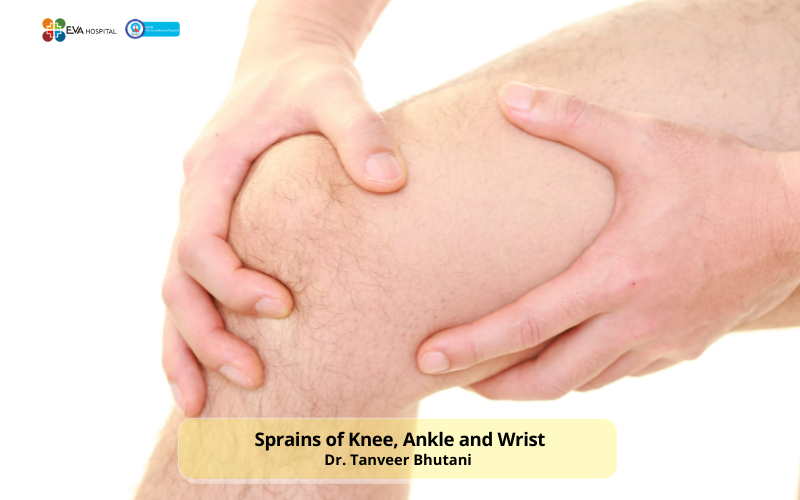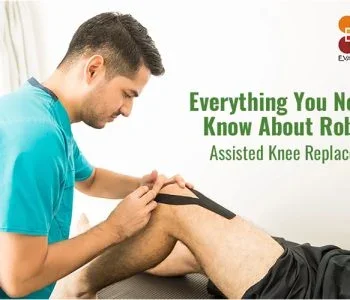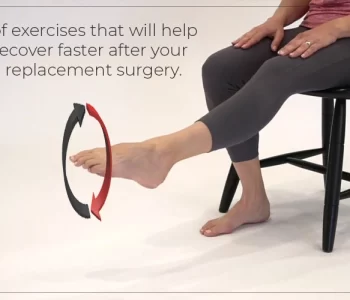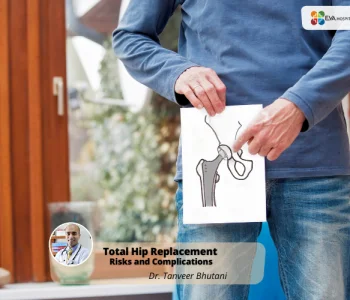Sprains of Knee, Ankle and Wrist
 Eva Hospital
Eva Hospital
Sprains of Knee, Ankle and Wrist
What is Sprain?
The injuries that involve stretching or tearing of a ligament within the joint are called Sprain. A strong, fibrous band of rope-like tissue, ligament connects two or more bones at a joint. Having a sprain means having injured one or more ligaments.
The most common points that are vulnerable to sprain include ankle, knee, and wrist. The ligaments can be partially or completely torn in severe sprains, sometimes leading to surgery.
A sprain directly impacts the joint involved, with its severity ranging from the ligament being stretched, partially torn, or completely torn.
The severity of the injury depends on both the degree of the sprain and the number of ligaments involved.
Where do sprains occur?
A sprain can occur in any part of the body but there are some points more vulnerable to them due to the higher risk of injury from falls and trauma. The three most common spots in the human body vulnerable to sprains are the ankle, knee, and wrist.
- Ankle sprain: An ankle sprain usually happens when the foot turns inward while one runs, turns, or lands on the ankle after a jump.
- Knee sprain: A knee sprain occurs after a knee is hit or a fall. An abrupt twisting of the knee may also sometimes result in a sprain.
- Wrist sprain: The thumb and wrist pain is usually sprained when one falls and lands on an outstretched hand.
Risk Factors of Sprains
Although a sprain can happen to anyone, ones with the higher risk are those:
- Who have a history of sprains
- Who are in poor physical condition or are overweight.
- Who takes part in a lot of physical activity on uneven surfaces.
- Who suffer from fatigue and their muscles are tired.
Sprains Causes
The most common cause of sprain is usually a direct or indirect injury that overstretches and knocks the joint out of position, occasionally tearing the supporting ligaments. These can include:
- Rolling of the ankle while running, changing direction, or while landing from a jump.
- A fall or slip on a wet or uneven surface.
- A blow to the body, like in contact sports or a shift in balance and falls.
Signs and symptoms of sprains
Signs and symptoms may vary due to the severity of the injury and can include:
- Pain and Bruising
- Swelling due to underlying inflammation within the joint or the soft tissue surrounding the joint.
- Instability if the joint is weight-bearing like the knee or ankle.
- Inability to move and use the joint.
- Hearing or feeling a “pop” sound in the joint at the time of injury
When to See the Doctor?
Though sprains can be treated at home with some rest and ice, the injuries that cause sprains can also be a cause of serious injuries, such as fractures. One should immediately see a doctor if one:
- Is unable to move or bear weight on the affected joint
- Experiences pain directly over the bones of an injured joint
- Has numbness in the injured area
Diagnosis
The most common methods of diagnosis of a sprain include:
- Doctor Examination: A doctor takes the history and performs a physical examination to establish if both are consistent with an injury to the joint, and might have injured one or more ligaments. Swelling, range of motion, and stability of the joint are also checked by the doctor.
- Imaging tests: An X-ray is done to make sure that there is no broken bone. Depending on the doctor’s examination or the patient’s response to initial treatment, more imaging tests like an ultrasound or MRI may sometimes be recommended to further assess the injury.
Different Types of Sprain
The degree of a sprain depends on how badly the ligaments in the ankle or wrist are injured. These include:
- Mild sprain involving just a mild stretching of the ligaments.
- A moderate sprain is a combination of stretching and some tearing of the ligament.
- Severe sprain involving a complete tear of the ligament.
Sprains and Strains Treatment
After properly assessing the sprain, the orthopedic doctor recommends treatment based on the level of injury. The treatment usually includes
- Protection: The area needs to be immobilized, preventing further motion and restoring alignment. The patient may sometimes be advised to use a brace or crutches
- Rest: Regular activity and exercises need to be curtailed. A change in your routine becomes mandatory to allow the area to heal.
- Ice: Application of ice packs to the injured area for 10 minutes, four to eight times a day.
- Compression: A continuous pressure on the injured area can help reduce swelling. An ACE bandage or compression stockings can be used to wrap the affected area to prevent swelling.
- Elevation: Keeping the injured area elevated on a pillow focusing on keeping the injury above the level of the heart can aid healing and recovery
- Surgery: The severity of the sprain and the joints involved can sometimes make surgery a necessity to treat the sprain. An experienced orthopedic surgeon can evaluate the injury and its potential to heal both with and without surgery, depending on age, activity level, and risk factors, and make recommendations for the surgery based on the evaluation.
- Physical therapy: Physical therapy is often recommended for patients suffering from a sprain. Sprains can take time to heal and can also change the dynamics of the joint. A physical therapist can help the patient to regain strength and mobility in the joint, teaching the exercises, as well as giving a home exercise program, to prevent stiffness of the injured joint. Strength building and balancing exercises are increased over time until the patient is back to a pre-injury level of activity focusing to make the affected joint even stronger than before
Prevention of Sprain
Dr. Tanveer Bhutani, a highly experienced orthopedic surgeon at Eva Hospital says that the time of recovery from a sprain depends on the severity of the injury.
Whereas the recovery may take only a few short weeks for mild strains, more severe sprains can take up to 12 weeks to heal.
He adds that, although the Surgical repairs of the completely torn ligaments have the longest recovery with the healing and post-operative plan outlined by the surgeon, it can help a person to completely recover from severe sprain and if the patient follows the recommended timeline for recovery as recommended by the doctor.
Dr. Tanveer Bhutani is a highly competent orthopedic surgeon who specializes in sports injuries and all kinds of sprains. If you feel a pain where a certain joint has stretched too far, do book an appointment for further assessment of your condition.









